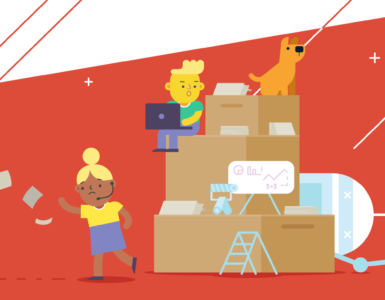In today’s workplace, casually strolling over to a coworker’s desk for project discussions is becoming rare. Instead, real-time interactions are being replaced by asynchronous communication methods.
Even in the office, colleagues are often occupied and prefer messages through chat platforms. This shift towards asynchronous communication allows remote employees to stay connected without missing critical discussions happening in the office.
Even for office workers, differing schedules and on-the-go tasks make asynchronous communication more practical.
In this article, we will walk you through the concept of asynchronous communication and highlight its distinctions from synchronous communication. We will provide relevant examples to illustrate how to effectively incorporate various forms of asynchronous communication into your work.
Understanding the advantages and strategies of asynchronous communication will enable you to enhance collaboration and productivity while accommodating the diverse needs of modern work environments.
What is asynchronous communication?
Asynchronous communication refers to the ability of two or more individuals to interact without the need to be simultaneously present at the same moment.
A classic example of asynchronous communication is when people communicate at different times and locations, offering more flexibility and convenience in their interactions.
In contrast, synchronous communication is a work meeting where all participants must be physically present at a specific location and time for the meeting to take place and be productive.
Synchronous and asynchronous communication
In short, synchronous communication involves real-time interactions, while asynchronous communication operates on individual timelines that can overlap across individuals and teams.
In most large workplaces, a combination of both methods is used, allowing for a balance between workloads with fewer meetings and essential real-time conversations for sharing information and resolving details.
Examples of synchronous communication include phone calls, virtual meetings, and in-person meetings. These methods involve face-to-face interactions, such as live training sessions, conference calls, and instant messaging, providing instant feedback and interaction.
However, synchronous communication can also include non-interactive formats like large conferences or presentations where the audience observes without immediate participation.
On the other hand, asynchronous communication examples include email, messages sent via platforms like Chanty, and sharing recordings via communication tools.
Asynchronous communication allows for messages to be left for others, who can respond at their convenience, checking in and addressing the comments or questions when it suits their schedules. This method offers greater flexibility and accommodates individuals with different availability and time zones.
Asynchronous communication: pros and cons
We deeply appreciate the benefits of asynchronous communication for boosting productivity and easing workloads.
However, it’s crucial to recognize the potential drawbacks as well. Let’s take a look at both aspects:
Benefits of asynchronous work:
- Protects flow states and deep work: With fewer interruptions from meetings, team members can immerse themselves in a state of focus and flow, enhancing productivity.
- Suitable for distributed teams: Async communication is especially advantageous for teams spread across different time zones, ensuring information reaches them at their convenience.
- Ensures documentation: All communication, whether written or tracked in project management tools, is recorded, facilitating easy access to essential information and lessons learned.
- Encourages clearer communication: Team members can gather their thoughts, refine their messages, and provide in-depth updates, resulting in more precise and effective communication.
- Yields higher-quality solutions: Independent problem-solving allows team members to spend more time contemplating issues and arriving at better solutions.
- Empowers productivity: Asynchronous work lets team members set their own schedules, tapping into their peak productivity hours.
Drawbacks of asynchronous work
- Not immediate: The main drawback is the lack of real-time communication, which can be a challenge depending on the message’s urgency and purpose.
- Time-consuming: Written forms of communication, while detailed, can take longer to compose, potentially affecting efficiency.
- Silos reduce transparency: If communication tools are siloed, it may hinder access to information and collaboration. Shared sources are vital for effective asynchronous communication.
- Lacks interpersonal connection: Although efficient, asynchronous communication lacks the real-time connection found in face-to-face interactions, which is vital for team bonding.
- Lack of visual cues and context: Without face-to-face conversations, visual cues and contextual information may be absent, leading to potential misunderstandings in important discussions. Consider using live communication for conflict resolution or feedback sessions.
In summary, asynchronous communication offers valuable advantages in productivity and flexibility, but organizations must be mindful of addressing its limitations and fostering an inclusive and balanced communication approach to ensure effective teamwork and collaboration.
Asynchronous communication best practices for remote teams
When operating within a remote and dispersed team, incorporating asynchronous communication tools like email and collaborative project management platforms proves invaluable in bridging time and availability differences across the organization.
- Assessing how your team members allocate their time
Given the staggering 252% rise in meetings since early 2020, there has been a noticeable decline in the time dedicated to actual task completion. Acknowledging this trend emphasizes the need to prioritize efficiency and focused work time. Conducting a thorough evaluation of time allocation can reveal opportunities for leveraging asynchronous communication methods, such as emails and project updates using management tools, to benefit your team.
- Set clear deadlines on all platforms
Ensure well-defined timeframes across all communication platforms, establishing explicit deadlines is crucial for successful asynchronous communication. Recipients should be informed of the expected response time, internal milestones, and the overall project completion date. Utilizing the deadline-tracking features in most project management tools can significantly aid in keeping projects on course, even in remote work settings.
- Write clear, concise messages on all platforms
To craft precise and concise messages on all platforms, clarity is a key element in effective asynchronous communication. Any ambiguity can lead to a chain of back-and-forth exchanges, hampering progress. To maintain seamless flow, consider anticipating potential follow-up questions from the receiver and proactively addressing them in your message.
- Craft detailed responses
Provide comprehensive and thorough responses. When your team sends you questions through asynchronous communication methods, take the necessary time to offer detailed and comprehensive answers. Although a quick response may seem efficient, it can lead to missed details and trigger a series of back-and-forth exchanges, causing delays in projects. Abundant details are essential for successful asynchronous communication.
- Don’t schedule meetings if you don’t need to
Avoid unnecessary meetings. One advantage of asynchronous communication is the ability to make progress without the need for scheduled meetings. Utilizing emails and comments in shared documents can be highly effective and replace virtual or in-person meetings. However, it is essential to recognize when a meeting is genuinely necessary to address specific matters effectively.
- Embracing an asynchronous workflow
Adopting an asynchronous workflow is an excellent method to empower your team, enhance productivity, and improve decision-making while promoting transparency.
This type of communication also facilitates cross-functional collaboration, offering better visibility into essential project details. To ensure effective asynchronous communication, it is essential to have a centralized platform for storing and sharing information. Utilizing a shared source of truth, such as Chanty, a work communication tool, enables seamless organization, collaboration, and access to all necessary resources for your team to excel in their work.
Using Chanty for all your asynchronous communication needs
Chanty is an ideal solution for meeting all your asynchronous communication needs in the workplace.
This powerful work communication tool offers various features that enable seamless collaboration, organization, and information sharing, enhancing productivity and teamwork.
Here’s how you can leverage Chanty for effective asynchronous communication:
- Real-time messaging: Chanty’s real-time messaging feature allows team members to exchange instant messages, fostering quick communication without the need for synchronous meetings. With the ability to send text-based messages, voice notes, and files, you can keep everyone informed and updated efficiently.
- Channels and threads: Organize discussions and projects into channels and threads to keep conversations focused and easily accessible. This structure ensures that team members can easily find relevant information, reducing the need for back-and-forth communications and streamlining work processes.
- Task management: Chanty offers task management features that help you assign and track tasks within the platform. Team members can collaborate on tasks, provide updates, and set deadlines, promoting clear communication and accountability for project progress.
- Integrations: Chanty integrates seamlessly with various third-party tools and platforms, making it easy to connect to your work environment. Integrations with project management tools, file-sharing services, and other applications further enhance productivity and streamline workflows.
- Accessibility across devices: Chanty is available on multiple devices, including desktop computers, smartphones, and tablets. Team members can stay connected and engaged, regardless of their location or time zone, enabling true asynchronous communication for remote teams.
- Announcements and pinned messages: Use Chanty’s announcement and pinned message features to highlight important updates, deadlines, or project milestones. This ensures that critical information remains at the forefront of team discussions, improving team communication.
- Notifications and alerts: Customize notification settings to receive alerts for specific channels, threads, or keywords, allowing team members to stay informed without feeling overwhelmed by constant notifications.
By leveraging Chanty for your asynchronous communication needs, you can create a cohesive and productive work environment where team members can collaborate efficiently, exchange ideas, and work together toward achieving common goals.
Embracing powerful tools can enhance your team’s communication, boost productivity, and ultimately lead to greater success on your projects.
Do you want to explore how Chanty can enhance your team’s asynchronous communication and go beyond expectations?
Start your free one-month trial now and experience why over 20,000 users rely on Chanty’s trusted platform.









Add comment